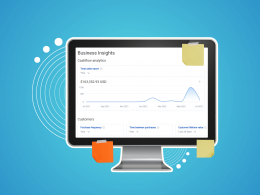Success in SaaS and ecommerce companies isn’t just about making sales and outdoing yourself every quarter. Under the surface, increasing costs, customer churn, or weak cash flow can carve into profitability. That is why financial analysis is so important: it converts raw numbers into actionable insights. By analyzing income statements, balance sheets, and cash flow reports, business owners can gain a clear understanding of performance and make strategic decisions.
This article will take a look at the essentials of financial analysis, including how cash flow can be used as an indicator of true business health, how to interpret financial data accurately, and the common mistakes to avoid.
What is financial analysis and why does it matter?
Financial analysis is the process of reviewing financial data such as income statements, balance sheets, and cash flow reports to understand performance and make informed decisions. For SaaS and ecommerce businesses, it’s essential because growth can hide underlying issues. Sales may look strong on the surface, but rising costs, high churn, or weak cash flow can put long-term success at risk.
I worked with an ecommerce client who celebrated record sales but didn’t realize that shipping costs and returns were cutting into profits. By analyzing their financial data in detail, we uncovered the problem and made changes to pricing and operations. Within one quarter, their net income improved significantly.
In SaaS, financial analysis shines a light on recurring revenue, churn, and customer acquisition costs. These insights help founders know when to invest in product development, expand their team, or conserve resources. Instead of relying on gut feeling, they can use clear financial data to plan strategically.
At its core, financial analysis turns raw numbers into clarity. It gives business owners confidence, helps them anticipate challenges, and creates a foundation for sustainable growth.
Key techniques for effective financial analysis
Effective financial analysis combines accurate data with methods that reveal trends and opportunities. Three techniques stand out for SaaS and ecommerce companies.
Trend analysis
The first is trend analysis, which highlights revenue growth, expense changes, and seasonality. For example, I worked with a SaaS client who faced flat income while operating expenses kept rising. By spotting this trend, we adjusted their budget and extended their cash flow runway.
Ratio analysis
The second is ratio analysis. Ratios such as gross margin, liquidity, and lifetime value to acquisition cost provide context that income alone can’t. An ecommerce client discovered through ratio analysis that certain high-volume products were dragging down profitability. When we shifted focus to higher-margin items, they quickly increased income and improved financial health.
Variance analysis
The third is variance analysis, which compares actual results against budgets or forecasts. This provides immediate feedback and allows leadership to pivot quickly. With automation tools like Synder, variance reports are faster and more accurate because financial data from multiple platforms is kept clean and consistent.
Together, these techniques turn analysis from a backward-looking exercise into a tool for guiding decisions that drive the business forward.
Using cash flow to measure business performance
Cash flow is one of the clearest measures of business performance because it shows how much money is available to operate and grow. Unlike an income statement, which reflects profitability, cash flow reveals whether a company has enough liquidity to cover expenses and seize opportunities. This is especially important in SaaS and ecommerce where payment timing, subscriptions, and inventory purchases can strain resources.
For SaaS, cash flow analysis often highlights runway: the number of months a company can sustain operations before needing new funding. I worked with a SaaS client who had strong annual contracts but still faced short-term shortages. Creating a rolling cash flow forecast, we adjusted billing schedules and built reserves to avoid interruptions.
For ecommerce, cash flow highlights how quickly sales convert into available funds after factoring in inventory, shipping, and advertising costs. One online retailer I supported struggled with cash gaps before restocking busy seasons. Using Synder to sync transactions and build forecasts, we gave them visibility into tight periods and planned financing ahead of time.
By tracking cash flow consistently, business owners can measure whether growth is sustainable and make decisions with confidence.
How to interpret financial data for strategic decisions
Interpreting financial data means using analysis to guide strategy, not just to report results. For SaaS and ecommerce leaders, this involves connecting numbers to business goals and adjusting decisions accordingly.
Nuances for SaaS
In SaaS, recurring revenue, churn, and acquisition costs tell a story about product adoption and customer satisfaction. I worked with a SaaS company where income was growing but lifetime value was shrinking. By interpreting the data, leadership focused on customer retention and improved profitability.
Nuances for ecommerce
In ecommerce, analyzing financial ratios by product or channel helps identify where to invest. One client realized Amazon sales drove high revenue but low margins compared to direct website sales. By reallocating marketing spend to higher-margin channels, they quickly improved net income.
The key is turning financial data into context. Dashboards, variance reports, and ratio analysis provide actionable insights. With accurate bookkeeping and automated integrations like Synder, businesses can spend less time cleaning data and more time making informed strategic decisions.
Avoiding pitfalls in financial analysis and interpretation
Financial analysis is powerful, but missteps can lead to poor decisions. A common pitfall is celebrating revenue growth without checking profitability. I worked with an ecommerce client who scaled sales aggressively while offering deep discounts. Their income looked strong, but margins collapsed. Once we analyzed gross margin ratios and adjusted pricing, profitability returned.
Another mistake is ignoring cash flow. SaaS businesses often assume recurring revenue guarantees stability, but deferred income and churn can create sudden shortfalls. Without regular analysis, companies may face liquidity issues at critical times.
Data quality is another risk. Manual entry errors or duplicate transactions distort results and create false confidence. Automating financial data collection through Synder reduces these risks and ensures reports are accurate.
Finally, many businesses fail to evolve their analysis. Metrics that matter for a startup are not the same as those for a company preparing for global expansion.
Avoiding these pitfalls requires reliable financial data, automation, and consistent interpretation. When managed properly, analysis becomes a tool for clarity and growth rather than confusion.
Analyzing financial data: Final words
Financial analysis goes beyond reporting and serves as a decision-making tool that helps SaaS and ecommerce businesses operate sustainably. By using trend, ratio, and variance analysis, leaders can discover secrets that can create challenges and opportunities.
Monitoring cash flow on a regular basis brings confidence to manage cash flow and fund growth, and careful interpretation of financial data ensures that the strategy is based on reality rather than conjecture. When done correctly and supplemented by reliable automated data gathering, financial analysis forms the basis for informed decision-making, enhanced profitability, and long-term success.






